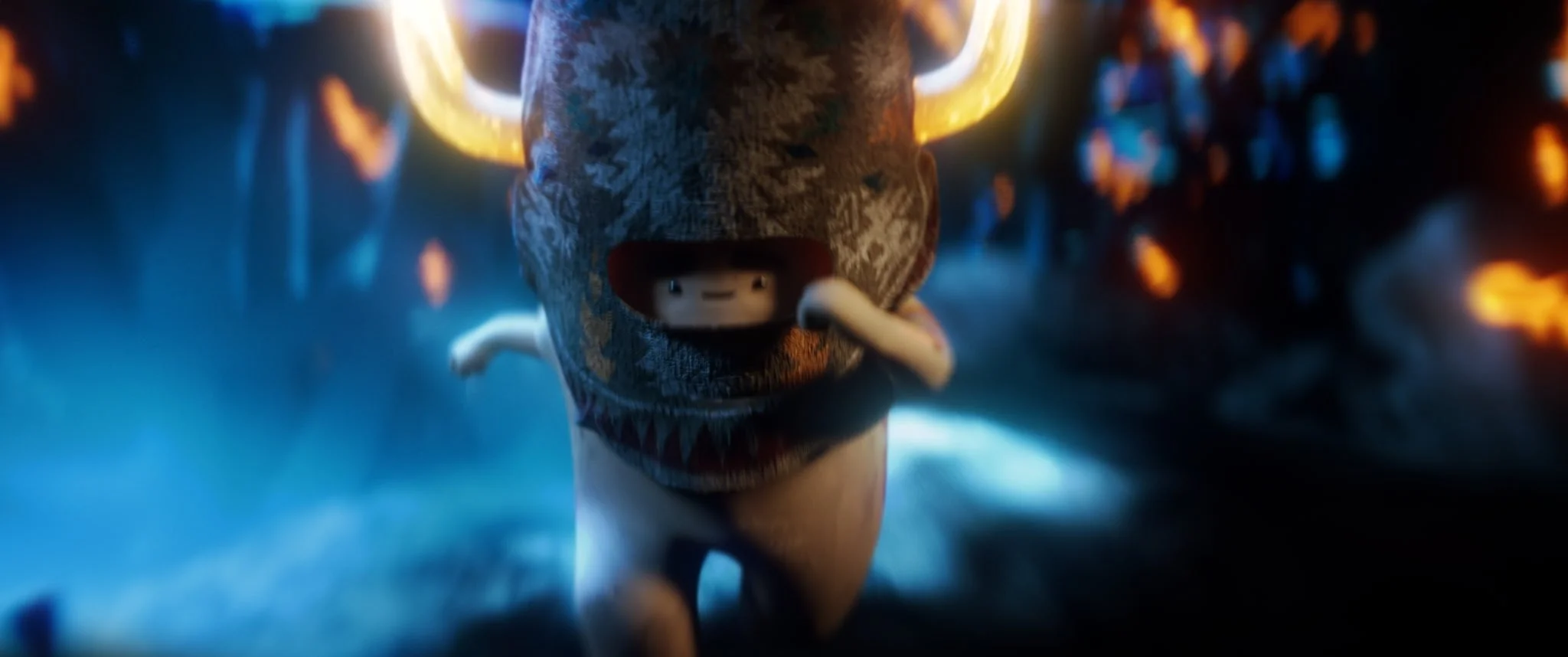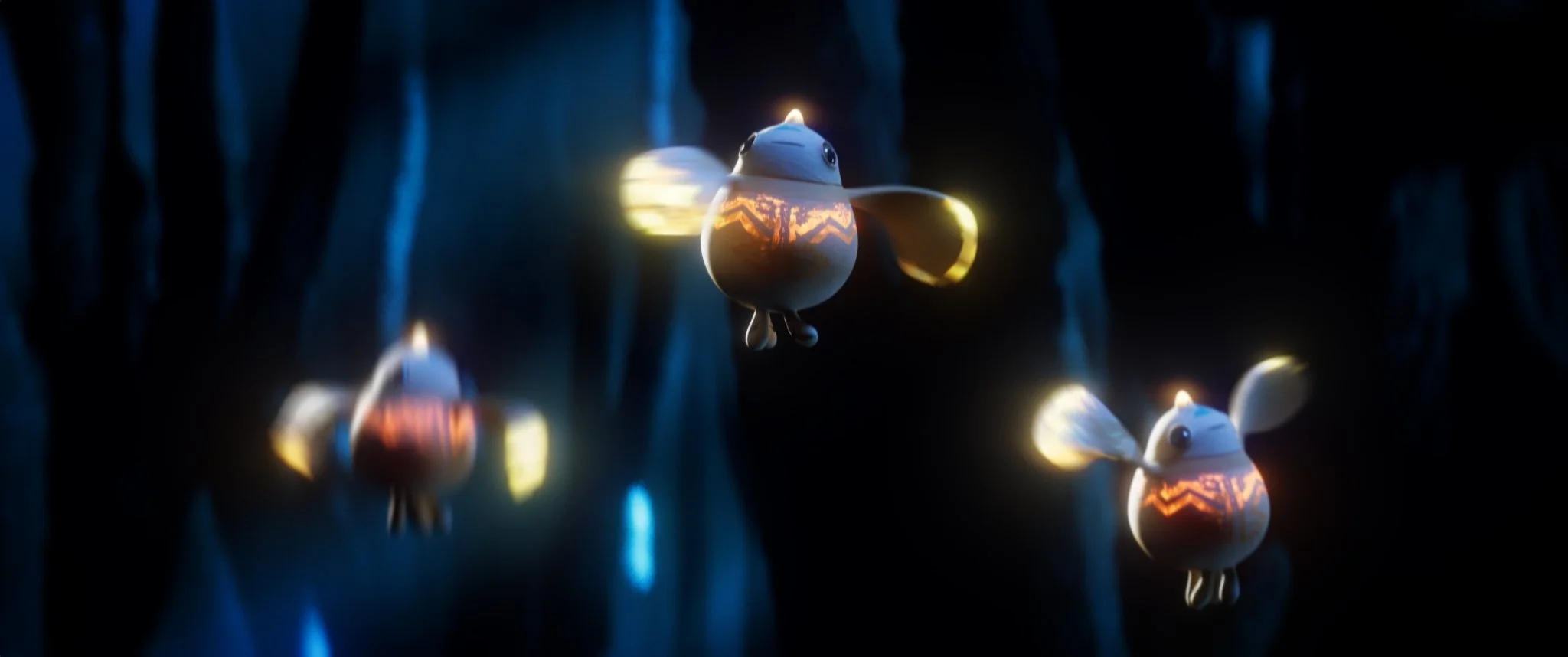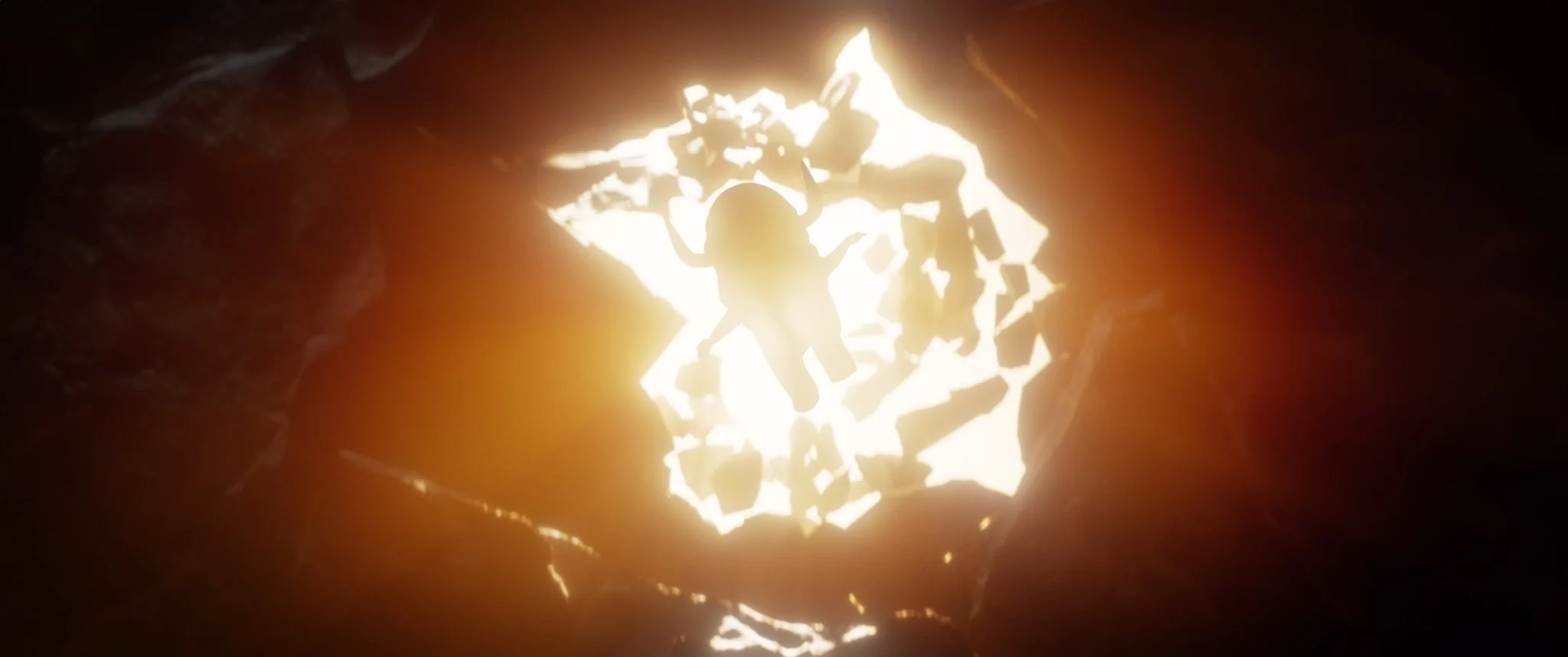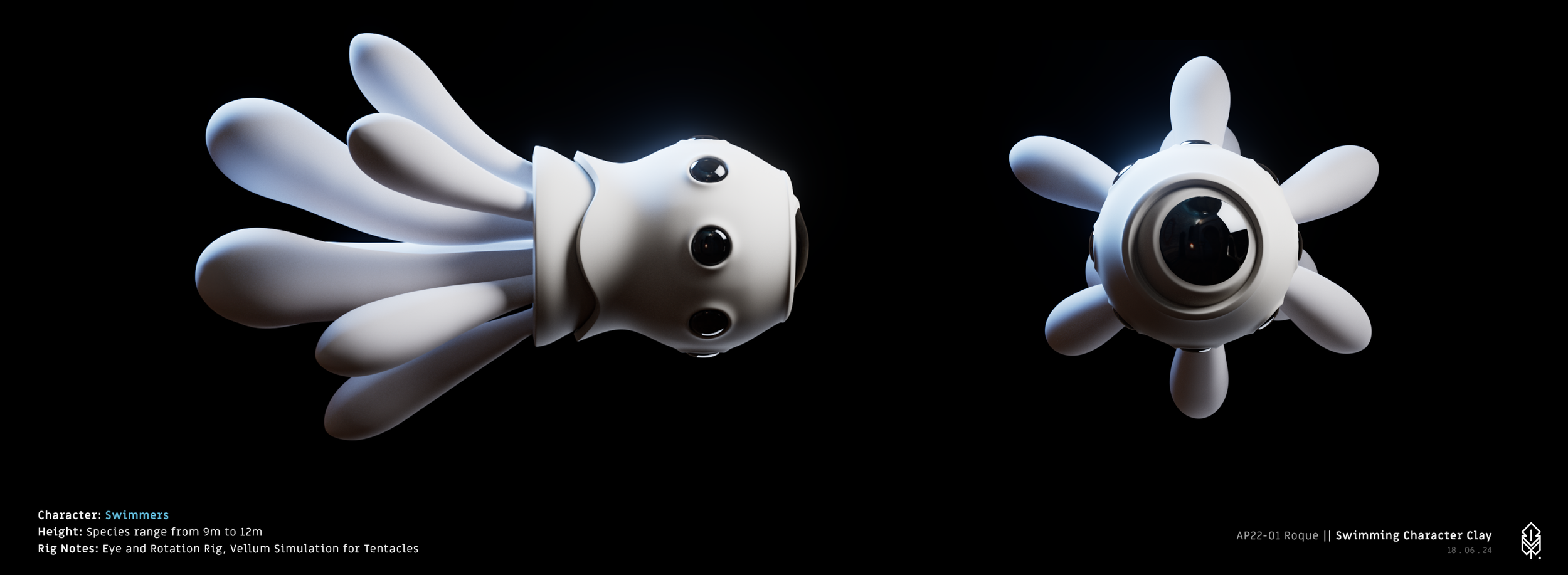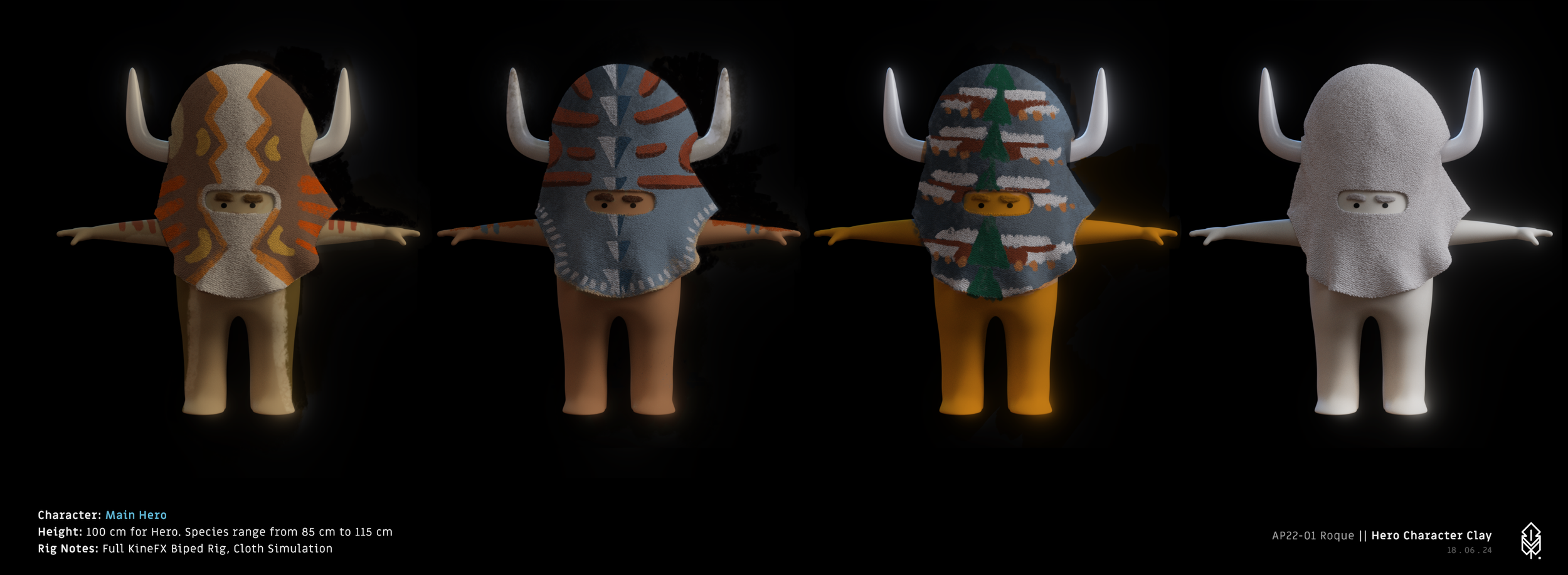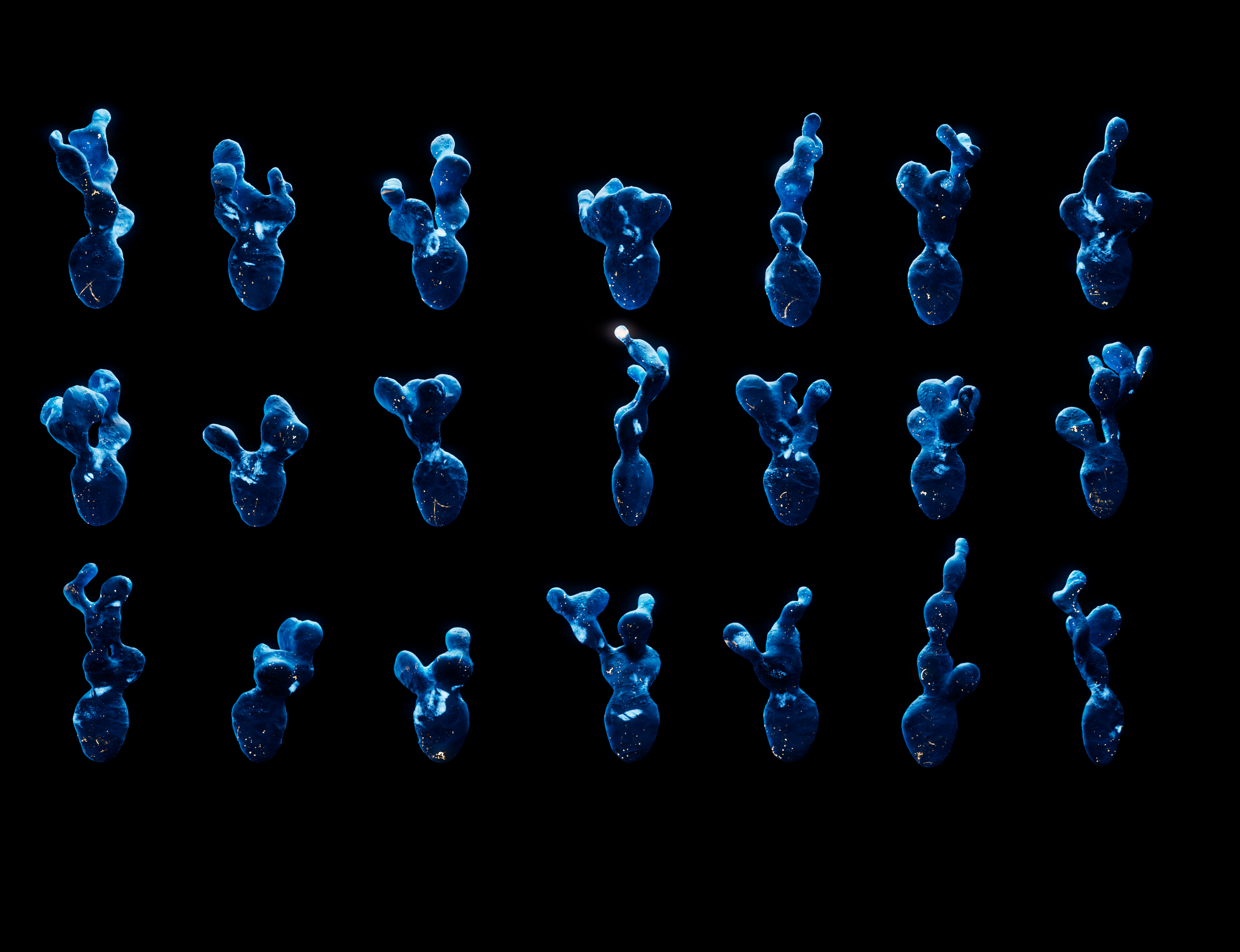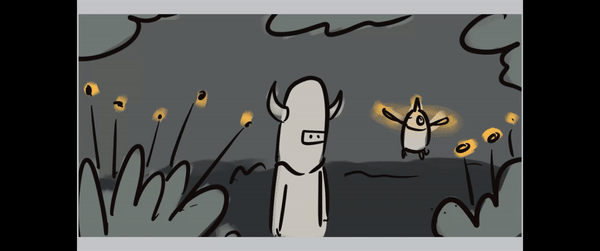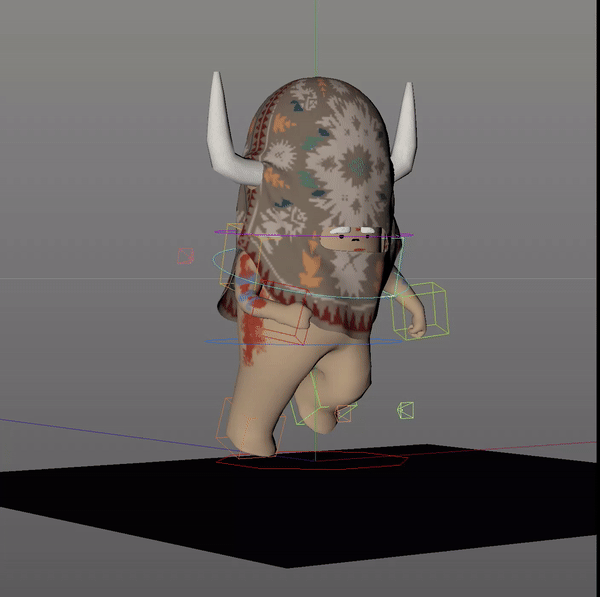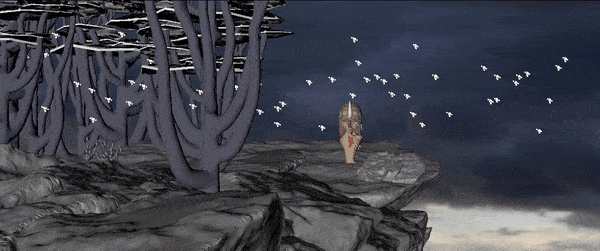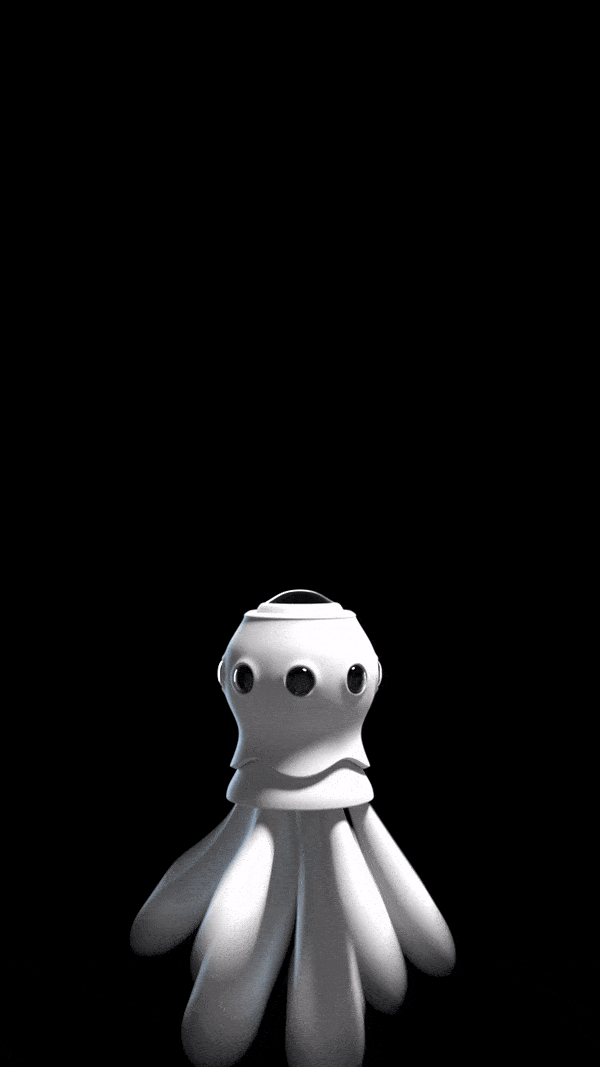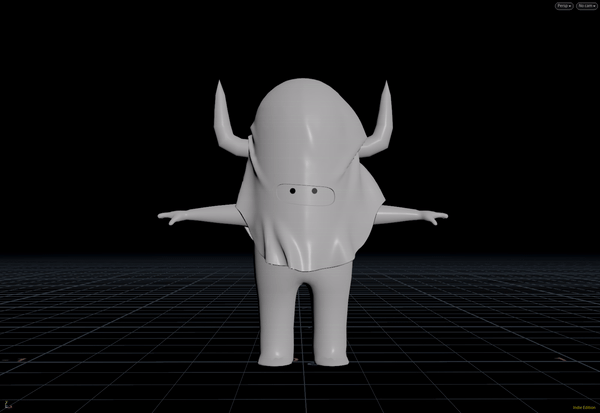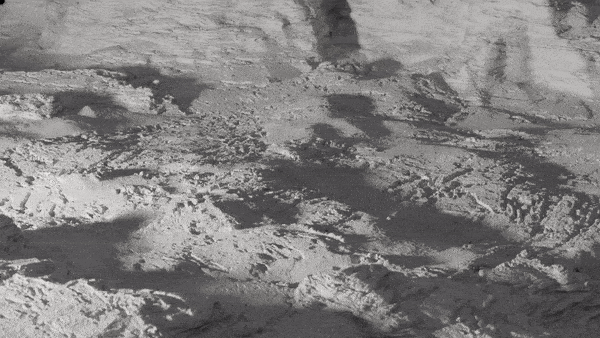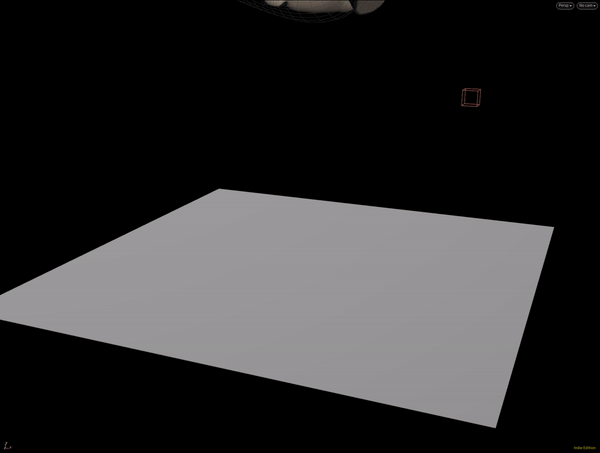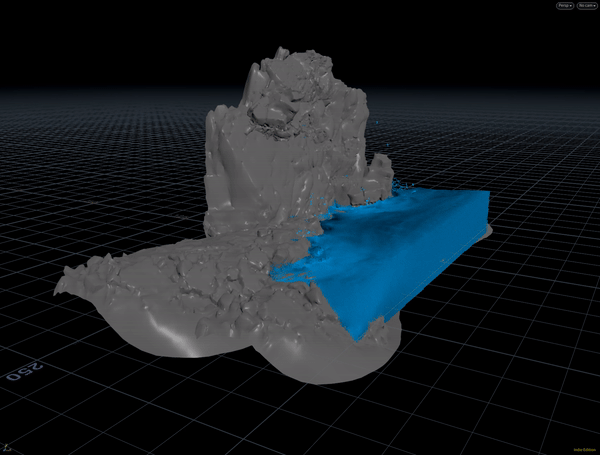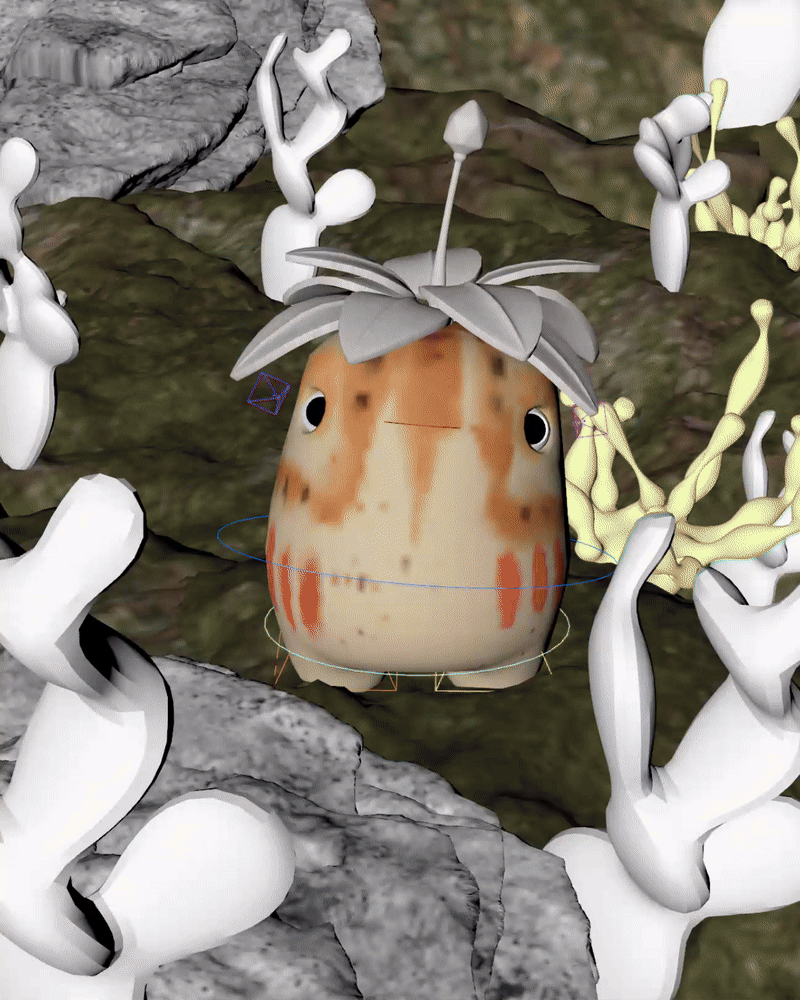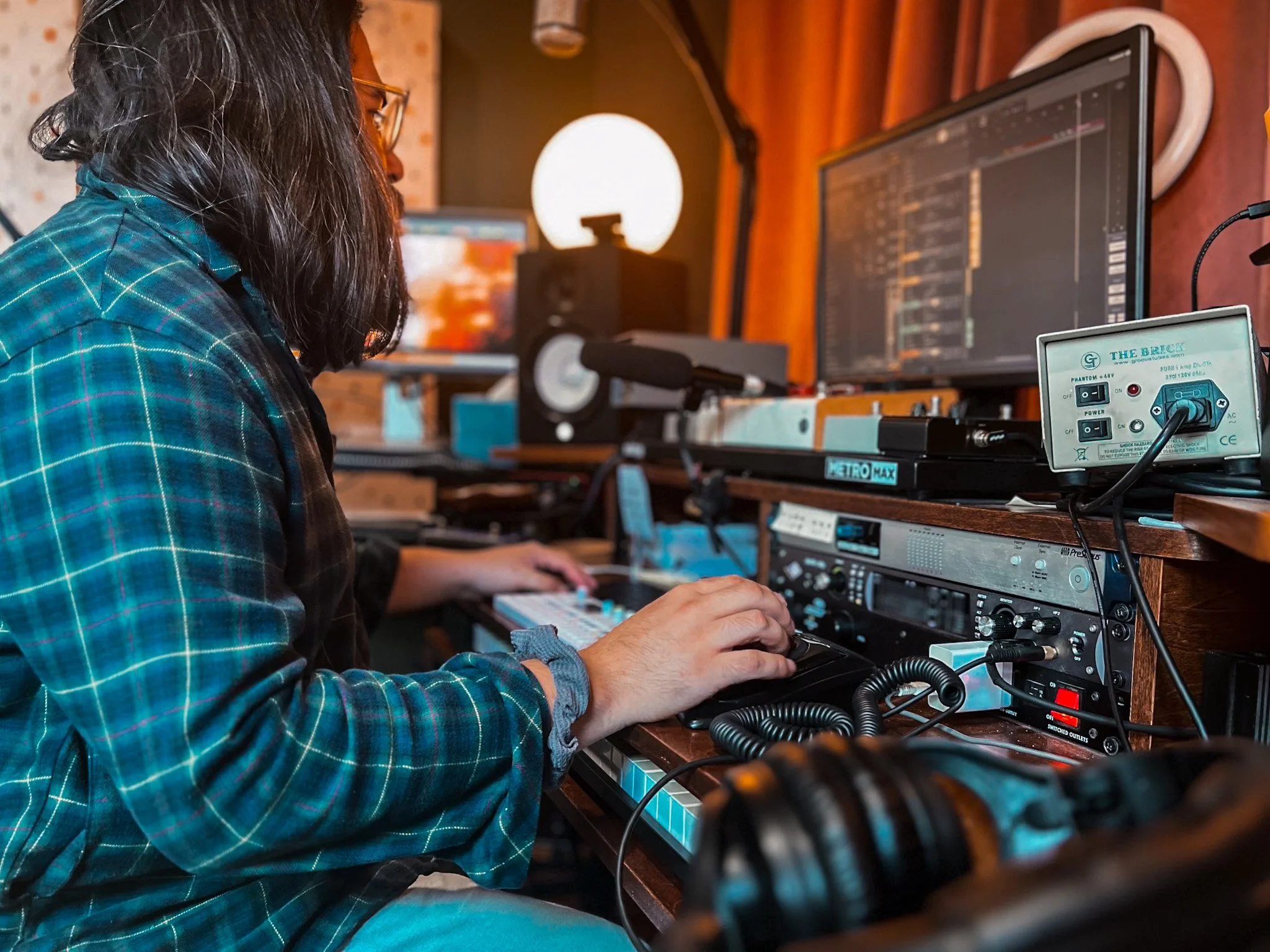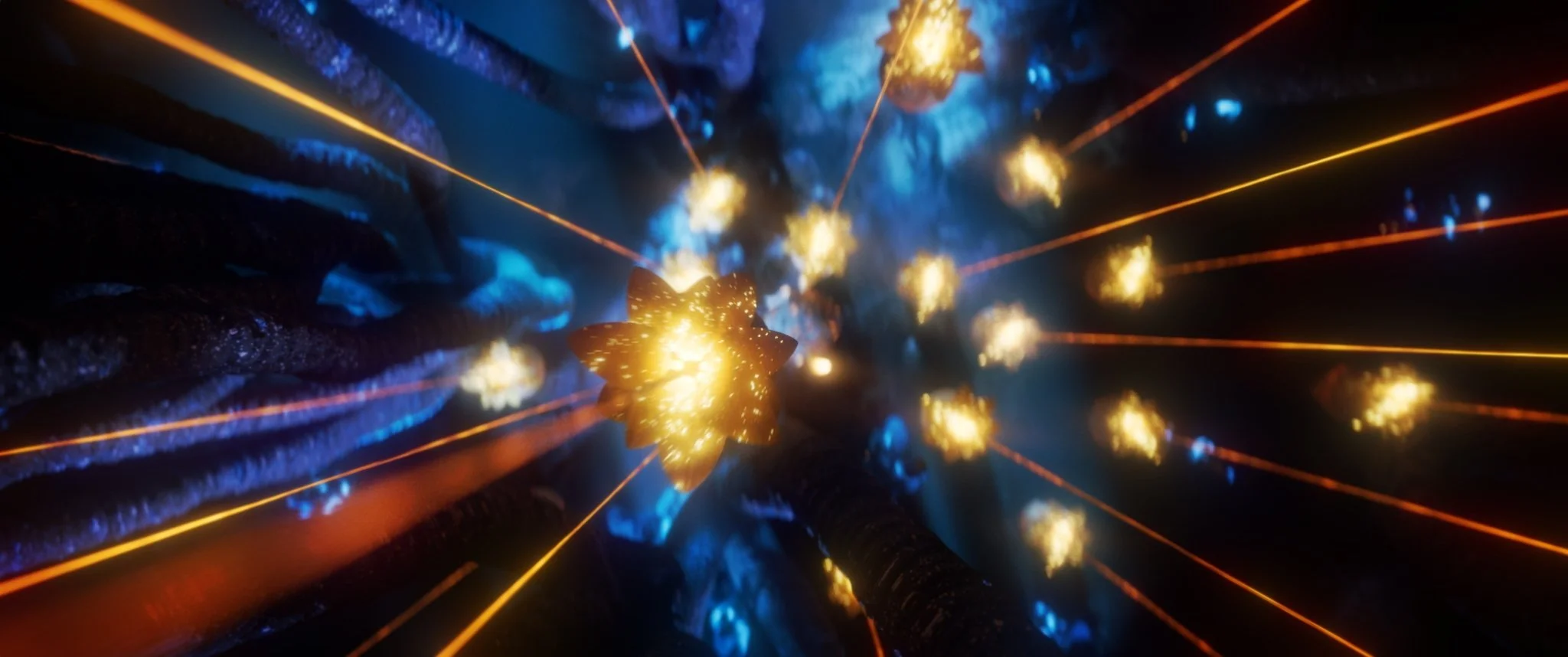
Beyond
Beyond is the story of a little hero as he makes a journey from loneliness to finding community. On this journey, he encounters an array of fascinating creatures and environments, always looking to experience the new opportunities in front of him but hindered by his inability to follow where they are heading. Ultimately, his journey leads him to a place of peace and resolve, within a community that he can fully be a part of. Following the archetypal story laid out in books such as Herman Hesse's Siddhartha and Homer's Odyssey, 'Beyond' shows the importance of determination and resolve in finding your own way, and pushing through challenges, darkness, and depression to find a place of peace. For a deeper history and a look behind the scenes at the process of making the short, continue reading after the video, but first, please enjoy, Beyond.
One of our biggest productions to date, Beyond is a deeply personal journey, through depression, desperation, and searching. There is light at the end, and there is a warmth of belonging waiting for all of us on the other side.
Credits
Production Studio
Ambient Press
Director
Jake Wegesin
Story
Jake Wegesin
Jordan Ruiz
Score
Jordan Ruiz - Good Nook Studios
Awards + Recognition
STASH Magazine
Jake Wegesin Searches “Beyond” in New Short Film
Motionographer
‘Beyond’ is the story of a little hero as he makes a journey from loneliness to finding community.
Case Study
If you want to pull back the curtain and see how this film was made, from start to finish, keep on reading. We have put together a comprehensive breakdown of how this world went from imagination to reality.
It is always a fascinating exercise to go back and reflect on the journey each short film has taken after production is finalized. It is a chance to look back through the different lives each short has taken on in their journeys to become fully realized and polished animations. This one, however, has a bit more of a winding path than others we have created in the past. This one pre-dates even the formation of Ambient Press. As this short was animated as a one man team by one of our directors, Jake Wegesin, we will let him take it from here.
The first iteration for what would become 'Beyond' was formulated during my time living in Copenhagen. Aside from my wife and one or two of my closest friends, few people know how difficult of a time this was for me. More than at any other point in my life so far, it was here that I felt the most alone, the most lost, and completely trapped. I have moved around a lot throughout my life, originally leaving home in Atlanta, GA in the United States to attend a university in Nashville. After a few years, I left and moved to Seattle. A few years later, it was off to England, then France, Ireland, Canada, New Zealand, and finally, Denmark. Moving around like this had always felt like steps forward, a path leading me to something bigger, a place where I would fully fit in. But as I started to formulate the first draft for this film - originally titled 'The Dark' - I felt for the first time that my decisions had led me into a solitary prison. The original idea was centered around how a little hero, wandering alone in the desert, sees great big structures all around him, built by others like him. Feeling left out, he decides to build one of his own - higher and higher, bigger and bigger. He is following what he believes is normal and expected, but by the end of his building, he discovers he is trapped inside. A prison of his own making. This reflects the mind state I was in at the time, trapped and feeling like all I could think about was escape.
Although this captured my feelings at the time, it missed the bigger point - a more optimistic note. I was so trapped in a cycle of depression and anxiety that I couldn't see what the wider story was - that is where my good friend, collaborator, and creative partner on this film came in. Before Jordan was a co-writer on this film, he was a friend to me, helping me see through what felt like an all engulfing darkness. Fast forward to a year later and my wife and I had moved back to France, I had started Ambient Press and was creating stories again that I could be proud of, and we had landed, seemingly by pure luck, in a community of wonderful people in a town we love. Jordan and I began having monthly meetings where we would discuss this project. Ever since 'Next Flight Home', we had been wanting to work together on an animation from start to finish, and it quickly became evident that this project was the one to pursue. With Jordan's contribution, we were able to land on the story of finding community in a broader journey. The core of the story was finally discovered, and we could begin working on the more detailed outline, character designs, and music explorations.
I have done my best, in the writing that follows, to provide context to all of these steps in the production process and to describe the many iterations that we went through in our journey to bring this film to life.
Character Design
With my short films, it can often be challenging to figure out whether the full story or the character designs come first. Oftentimes, the story helps to inform what design limitations the character will have, and in other cases, like this one, certain mechanics of the character inform important story points. The main character went through many iterations (as can be seen in a few of the original concepts above) but landed quite early in the process on a biped with a hood and horns that glow. As an independent animator, I am always looking for ways to save on time and animating hours without losing the appeal of the characters themselves. Characters in blockbuster feature films will have thousands of controls to adjust the most minute of details in their faces and hands. In 'Next Flight Home' for example, each bird had seven controls. The goal of having a simple rigging and animation job is an early consideration baked into the identity of the character from the start so that it doesn't feel like we are cutting corners in the service of saving time down the line. For this film, the character has little blocks for feet necessitating very little animation in articulation or rotation. His hands have two fingers and a thumb each, the minimum needed to point, open, and close a hand. And most importantly, the simulated element, his hood, provides a large portion of the movement. This would allow me to create a pipeline for simulation and art direct elements of how it moved while allowing the computer to create natural and complex movement on its own. Maximum output for minimum input without losing sight of the heart of the character.
This realization about using simulation to drive a lot of the complex motion became the central tenet of all of my designs for characters in this piece. The tree climbers would have leaves and little bobbles on their heads that would be simulated as they moved around. They also live in the ground and climb trees with their little grappling hooks, so they clearly don't need arms, right? One less thing to animate. The birds could fly like helicopters, giving them an alien quality, unique and novel, while still simplifying the animation. Animating a single rotation axis for their wings is a lot simpler than animating multi-chained joints for a typical organic wing motion. The swimmers continued with this same ideology - over half of their bodies are tentacles that have no animation at all, only a tetrahedralized soft body simulation after their bodies are animated in each scene.
I believe that for designers, guidelines and restrictions are not necessarily limitations, but guardrails that help to focus creativity in a unifying direction. Creating characters that needed as minimal rigging and animation as possible ended up helping me to create characters that felt unique and new, rather than minimizing my possibilities. Below, you can see the final character sheets before any rigging or surfacing took place.
Final Models
Once the characters were modeled, I moved on to surfacing. One interesting design challenge in this short was that the surfacing would require a lot more thought and attention than in the past. Rather than developing a simple wood material, or worn metal texture to apply to my characters, I wanted them all to have unique painted patterns, designs, and markings. I have long been inspired by the design systems that native americans developed, notably the Hopi and Pueblo peoples of the southwest. They are distinctive and bold, geometric, but inviting and warm. Aside from the solely visual side of the inspiration, there are elements of the traditional tribal structure that speak to community and connectedness in ways that our current society lacks. The central goal for our character is to find community, and by referencing the patterns used in native cultures, my aim was to pay homage to the connectedness that they are born from. I took the character sheets from the modeling process into Procreate on my iPad to start painting over each of the creatures, starting to imagine what they could look like. I ended up designing around 20 or 30 different options here, giving me plenty to decide from when it came time to paint the final textures in 3D.
Another key element to all of the characters would be the bio-luminescence. This was one of the earliest ideas for this piece that remained as a prominent element of the film over the two years it went through conceptual evolution. The central idea of this film is trying to find community, and the glow serves as a visual token of that feeling of togetherness. Early on in the short, we see three bugs come into frame, and as they turn to each other, they start to glow. This is a brief moment, but begins the nod to the idea that community brings light. Our hero's horns are his main method of glowing, but we also see when he is underwater that his hood has luminous elements as well. I knew that each character would have glowing elements, and after the surfacing was done, it was important to figure out how each of them would glow, and to what degree. Below, you can see the final concepts of the bio-luminescent elements of each of the characters.
Environment Design
Houdini is a procedural 3D application that excels at a lot of different tasks, but is unique in the 3D world in its efficiency and capabilities in creating systems that can be changed dynamically. This meant that rather than modeling out 100 different plants, I could design and model a single plant with a set of rules and parameter ranges. Once this was done, I could tell the program to give me 100 different plants that fit within those ranges. This is a technique commonly used in both film and game development, and is nothing new. However, this is the first time that I used this capability at scale, and it made populating the world of Beyond infinitely easier. Below, you can see some of the trees, plants, cacti, and rocks that were all developed using this procedural system and some of the various generations that the program created.
Story Development
As we arrived, our goal was clear - to leave one week later with a full set of storyboards and key character designs. It is interesting for me reflecting back on this time, because all of the days really did start to blur together for me. I would wake up early - around 4h00 thanks to jet lag - and go out for a run in the hills before the sun came up and the 40c temperatures came looking for us. On these runs, I was able to feel everything I hoped I would get from the trip. Inspiration and visual reference for plants, for rock formations, and creatures as well as the incredible peace that comes with being alone in the western deserts in the US. It was on these runs that I started to connect in a healthier and cleaner way with this story of darkness and depression. Every morning, when I got back, we would make breakfast, and then Jordan and I would start talking about the story for that day. As we would throw around ideas, I would take scribbled notes on index cards noting things like 'over the shoulder hero' or 'wide lens tracking shot'. After a little while, we would take a break and I would go off to sketch all of those index cards I had just taken notes on. When we would get back together, we would lay out the cards I had drawn, discuss them, rearrange them, redraw them, throw them out, shift them. It was a new way for me to work with story, and it was incredibly fluid and fast. By the end of the fourth or fifth day, we had the entire story laid before us, every shot that ended up in the final film was visible on that floor. It was a moment filled with joy and fear as I looked down at the layout with Jordan as I realized that this story would undoubtedly be one of my proudest creations, but also fear that I actually had to make it now. Four key characters, an entire world, water, wind, and cloth simulations, and almost eight minutes of runtime on a fully 3D animated feature, all created alone. I am not sure how Jordan felt at that moment, but I was overflowing with excitement and doubt in equal quantities. But as the saying goes, it is often the things that terrify you that provide the most growth.
Before we had decided on a location, we knew on a wider scale what it was we would be aiming for. Desert, isolated, and in the Southwest of the USA. So much of the design inspiration comes from native tribes in the Southwest US that it really only made sense to go there and try to discover the art and environment for ourselves. On top of that, the story takes place in a lonely desert, and this would be the perfect opportunity for me to pursue what has long been a dream of mine - a research trip for a short film. On big animated productions, key team members typically go on trips such as these to get a sense of the landscapes, how the animals move, how the world sounds, and most importantly, how they feel in the places they will be aiming to recreate later on. Jordan and I discovered a little house for rent in a town called Apache Junction to the east of Phoenix. One of the last houses on the border with the Tonto National Forest, an imposing rock formation looming behind the house, and empty desert stretching for kilometers behind it, it was the perfect place. We packed our bags and met up in Phoenix.
The last thing I created while in Phoenix was the color script. A color script is a piece of art that provides the mood and lighting reference for an entire film or short. Popularized at Pixar, where they make one for every film, these painterly and impressionistic pieces show key scenes and moments from a film and offer a loose key for what the lighting will be at those points. This allows the director and all of the artists to stay on the same page as they move through the more technical elements of production. In this case, I was the director and all of the artists, so I can't vouch for how essential it was, but it did end up being a great reference document as I slowly got lost in the endless files, renders, composites, shots, and simulations of production. Below, you can see the original color script that was my guide to how the light would evolve throughout the film.
Once I was back in France, I set off working on the storyboards. The index cards were a great reference to the story as a whole, but they did not provide much concrete information for each shot and the motion that was going to take place. All together, I drew over 100 individual index card sketches for the story points. For storyboards, I drew almost 400 individual frames to edit together. Back on the iPad and in the land of digital tools, I put on my headphones and over the course of a week, I had all of the storyboards drawn out and pulled into Davinci Resolve to put together the first edit. This animatic was the first time Jordan and I could see the overall pacing, the movement, and get a more clear sense of what it was that we had actually created. At this point, there were a few changes that we made, shots moved around or erased, moments extended, and movements changed. But as this stage of the process was signed off, both Jordan and I officially had our guide for the next few months. He had something to start scoring the music to, and I had a long list of 71 shots, their descriptions, durations, and shot numbers that I needed to start creating.
At the beginning of this case study, I talked a little bit about the different forms that this story has taken on its path to becoming the video it ended up as. So much of the drive behind creating this came from me wanting to show a bit of the darkness that I was experiencing at that time in my life. If it were not for the support of my wife, Phoebe, and good friends such as Jordan, the co writer on this film, I am not sure where I would be today. Through rewrite after rewrite, revisions and brainstorming, Jordan and I discovered that the darkness was not the story, but a chapter. A small element in the wider journey of our hero. But even with that being decided, there were still large portions of the story and the world missing. Mechanics of how characters interact with each other, progression of the hero on his journey, and what the challenges were that he would face along the way. Living on other sides of the world from each other, Jordan and I are not blessed with a lot of time together. However, during a trip to California the December before, we decided that the time had finally come for us to work on something together. We set a date for the summer that we would get back together for a week and have an intensive creative workshop, setting aside all other work in order to get this short off of the ground.
Layout and Animation
After the last shot was finished with layout, I looped back around again to the beginning to start with the most time consuming process of the pipeline, but arguably the most important - animation. Animation takes a lot of time, a lot of iteration, and a lot of care. Simple things such as a character walking took me hours to get right. Trying to give something the feeling of weight, of effort, of feeling in a computerized world inherently void of those things is a pure challenge. However, that is the point of animation, it is why I love this job so much - the possibility. Working through shot after shot, day after day, week after week, the film slowly started to come together. I could see the feeling and emotion slowly injected into the edit with each new shot that was placed into the timeline. Animation on this project went incredibly quickly in relation to past projects I had done lending mainly to the simplicity of the character designs and rigs as discussed before, but also in my ability to re-use animations from shot to shot. The walking and running cycles, for example, were built once and reused and slightly altered as needed. This enabled me to tackle multiple shots with a single animation. On top of that, the underwater sequences are inherently float-y, simplifying the perpetual struggle of giving weight to animated characters. All in all, the animation for this short took just over 250 hours for a runtime of almost 8 minutes. Outside of the animation industry, that might sound like a lot, but from my side of things, that is just about as fast as I have ever animated anything in my life.
The next step in the animation pipeline is layout. This is where I go through all of the shots that I have storyboarded and get everything blocked into place. The character rigs are placed in the scene, rough placements for trees and plants are introduced, and camera positions, movements, and lenses are decided. This additional step helps to further refine the timing of each shot from the storyboard phase. For this short, I had a lot of shots where we either shortened or extended the timing once blocking animation was put in place. This step also gave me the chance to see how cuts between different shots would work and allowed me to change lenses as needed to help make those transitions smoother. All things considered, this is probably my least favorite part of the pipeline. It is simple, not overly technical. There are a few creative decisions being made, but not many compared to almost any other step in the process. And there is not a large jump in seeing what the final piece would be. However much of a drag this step felt like, I pushed through day after day, and after a couple of weeks, we had a full timeline with fairly concrete timing and movement, all shots built out in a rough outline that I could start animating with.
Simulation
Outside of the character's simulated elements, there were FLIP simulations I built for the ocean sequences, particle simulations for dust and plankton in the water, rigid body simulations for falling rocks and fractured sinkholes opening up, pyro simulations for smoke and dust, and customized vellum solvers to help animate leaves into specific positions while still being affected by natural forces. Houdini is a program I have used for years at this point, and it really is the key piece of software that makes a single person creating something like this film possible. My initial goal in starting this short was to create it fully in Houdini - something it is more than capable of. The USD integration for creating, placing, and rendering assets is mind boggling. The character tools for rigging and animation really do seem unmatched. However, when I create projects like this, I step away from paid projects and 'pay my own salary' for however long it takes, in this case, five months. As much as I wanted to stick to my initial goal, the time that I calculated it would take me to completely learn the new systems of KineFX, APEX, and Solaris made the cost of both learning and completing the project out of reach. I have used Cinema 4D for over almost 15 years now, and although, (no offense intended) I find it's tools for character work and large scale scene rendering vastly inferior to other tools on the market, it is the program I have the most experience with and the one that enabled me to complete this project in the time that I had available to me.
The next step in this long pipeline after animation was finished was simulation. This is where I got to switch out my director's hat for a technical director role and challenge the more mathematical side of my brain. I ended up building four dedicated pipelines for simulated elements on the four characters, simulating cloth for the main hero, vegetation for the climbers, legs and wings for the fliers, and tentacles for the swimmers. The main challenge in this exercise was developing the system for simulating the hood on the hero's head due to the face hole. As he needed to have the face hole line up at all times, I needed to anchor it in place somehow without it feeling static. I ended up doing a simulation of the hood on a static character, allowing the hood to settle naturally into place. Once I had this rest pose, I used soft constraints to hold the holes around the face and horns in place with varying values depending on the velocity, or movement, of the character's animation.
Lighting
Throughout this process of lighting, I am constantly referring back to the color script that I created back at the start of the project. In each shot, every scene, I aim to keep a sense of continuity in how the light changes and reflects the mood throughout the film. Below, you can see two examples of the color script that I started with, and where the final shots ended up.
Ah, lighting. This step in the process is such a breath of fresh air in the pipeline, and one that fully encompasses the idea of being both creative and technical simultaneously. At this point, the animation is done, the simulations are in place, and the edit is locked, all that is left is to give it all feeling, and a large part of that comes from lighting. Just like in real life, in the 3D world, we hand place different types of lights around the scene, adjust color temperatures and intensities, bounce cards and flags in order to sculpt the scene and direct the viewer's eye to where the key elements are. Without any lighting, the scenes are cluttered and confusing. However, with a key light that illuminates the central subject, a sharp rim light that separates them from the background, foreground and background accent lights to define the subjects out of central focus, and environmental lights to accentuate depth, the cluttered scene becomes structured and well defined.
Music and Sound
This specific synth used to belong to a friend of mine, Tom. At some point, while flipping through presets and saved sampled patches on it, I ran across one specific sound.
This patch isn’t native to the OP-1. At some point, Tom had recorded himself in his home in England playing this note on the clarinet, and through the OP-1 engine, it was playable in my home in Los Angeles.
This patch isn’t native to the OP-1. At some point, Tom had recorded himself in his home in England playing this note on the clarinet, and through the OP-1 engine, it was playable in my home in Los Angeles.
The bedrock of the Beyond, and most notably its opening notes, would end up featuring this patch heavily.
Before the storyboard or animatic had enough bones to hang music on, several patches were compiled into the palette that would become the score. I primarily looked for sounds on the OP-1, Mellotron, & Chord Organ that imbued a sense of depth and complexity that a lived-in world would have. The film, only being 8 minutes long, needed to convey to the audience that it was stark and wide and real. Not only did the film need sonic interest; the score was supporting the belief in the world of Beyond. Here are a few of the patches that I ended up reaching for continuously:
“SOFT HUM” & “LITEWEIGHT” on the OP-1 (neither of which I remember sampling - I’m not even sure it’s my voice humming):
This cheap, old K-Mart Chord Organ (which I think was intended to be a kids toy), recorded in the room. Its internal rotor, which you can hear at the beginning of this clip, has a whirring noise that felt correct for the world itself. In some places in the score, I’ve left it in to give the instrument more rickety-ness and wind.
While all of these colors felt at home in the expansive twilight of Beyond, the filter of the film had to be present as well. The world is exposed, eroding, real. There was a graininess to the rock faces and cliffsides. So while I’ve cleanly re-recorded these different instruments to capture their initial draw, none of them made it into the film in their pure form. Almost the entire score is tracked through a few key effect pedals to imbue the music with the same lo-fi twilight as our main character’s journey.
From gray pedal on right, to left: Union Tube & Transistor’s “LAB” Compressor, Milkman Sound’s “The Amp 50”, Walrus Audio’s “Slotva” Reverb, Mr. Black Pedals’ “Vintage Ensemble” Stereo Chorus, and key among them, Kinotone’s “Ribbons” Lo-Fi Medium Emulator.
While the Milkman lent tremolo and preliminary tone shaping, the Slotva added its tail here and there, and the Vintage Ensemble widened and warbled, “Ribbons” (the pink pedal in the left corner), became a staple. Its low & high passes were instrumental in shaping the amount of dust and grit that sat on top of the fundamental. Particularly in long, holding synth parts that were providing the bed for a scene, the top end hair and the presence of the bass note had to feel carved out correctly. I could quickly sculpt the overall shape of sound, and then give it imperfection with the built-in wow and flutter, tape saturation, and dropout emulator. Then, when the sound was right, I could use Ribbon’s onboard reverb to place it deeper inside the world.
About halfway through the process, I listened back to what I had at the end of the day, trying to hear from an audience’s perspective, and I was struck with a sense that something was missing. While the whole thing sounded full and musically interesting, I was in very lo-fi, indie-sounding territory. Too many ethereal, ambient, and difficult-to-identify sounds can lose the listener; the sound that people associate with picture is inherently orchestral (violins, cellos, horns, woodwinds, choir). Even avante-garde scores like Blade Runner or Eternal Sunshine of the Spotless Mind eventually lean on familiar grandiose instruments to keep things relatable.
On this particular project, it was worth keeping things small and in-house. But how do you impart the grandeur and legitimacy of the familiar without hiring out to a Hungarian orchestra? For Beyond, the answer lay in stacking.
I texted a friend of mine and spectacular string player, Phoebe Silva, to come to Good Nook studio here in LA. Since there was no firm ink written for the score, for two days we would find a section of the film, dream up small melodies, and layer the violin to absurdity. Each part would be layered eight-fold or more, with several different harmonizing parts for each section. Some sections already felt fairly thick to me, and just needed the extra bit of legitimacy that strings lend. The title card would be a good example. Here’s that moment without, and then with a simple orchestral string layer.
The “ORGAN”, “VIBES w/ VIBRATO”, and “FLUTE” samples from the Mellotron:
Other scenes felt ripe to explore and lean on this familiar sound. As soon as I had the idea to save space in the score and elevate it by relying on this kind of off-the-cuff orchestral layering, I started dreaming up and singing the parts that would eventually become the underwater section (when the main character is surrounded by these bioluminescent sea-creatures). I knew it had to feel like the height of pending joy for him; like a taste of the true belonging he’s been seeking over the course of the short. These blooming, interlacing string parts that ended up there felt like the perfect culmination. For context, here’s what the section felt like before the addition of the “orchestra”, and after.
Much of the score and sound of Beyond took shape before I had nailed down the integral melody that I wanted to thematically represent the main character’s journey to find belonging. Early on in the score, I relied heavily on strong holding fifths in the low organs and synths while the top of the harmony played between the parallel minor and major. The first place the would-be-theme appeared was in the run up to the title card.
The melody felt right pretty immediately. Almost like the first interval jump is this launch into the cosmos, and the residual fall is us finding our place among it. Because the last note of the melody is so squarely asking to be resolved, it became a functional part of telling the story (as with any good melodic theme). In the film, there are several moments where community and belonging is within the main character’s grasp, but the possibility is ultimately dashed. In line with this, I started reusing the figure and omitting the last note; the lack of melodic resolve would mirror the character’s journey. Here’s the melody in the beginning of the film, resolving into determination and mystery, foreshadowing the climb ahead.
Here’s the melody as it appears while our hero is surrounded by new tree-climbing forest-dwelling friends. As they disappear, the harmony turns minor and the figure lands on the fourth scale degree; wanting to “find belonging” by resolving to the third, yet unable to.
Here’s the melody as a trio of flying companions appear, and a brief moment of joy is experienced in community with them. As the film progresses, I wanted the theme to flirt with resolve even further. As the main character joyfully gives chase, it repeats, hanging on its passing third for a moment before it becomes abundantly clear our hero can’t follow, and then drops to the seventh scale degree, mirroring the cliff’s edge and the impending solitude.
When the hero begins his downclimb, I replayed it, taking care to underscore the third with a minor chord in the bass harmony.
And here, at the nadir of the journey, it appears again. Like in other sections, the melody doesn’t resolve, but here I wrote the chordal harmony underneath to shift and sour to underscore the emotional point; this is the most alone our hero has ever been. As he sinks, his hope to find community sinks with him. But as he hits what I referred to throughout the production of Beyond as “the floor of the world” and light sprouts beneath him, the theme grows and flowers again.
Throughout the process of scoring the film, in the many use cases of the theme, I felt that the melody was passing through these different chordal choices underneath it. None of them truly felt like the correct harmony to accompany it. So, perhaps fortuitously, it took me until the composition of the ending scene’s music to find the bass notes that welcomed the main theme with open arms - that fit together lock and key, like they had been waiting for the melody of our hero to drop (literally) into place. This scene is the first time these specific bass notes occur.
I also tried to keep this iteration of the main figure (which eventually becomes whole) feeling tentative at first. As if climbing through the world’s citadels of rock and falling through its watery vastness had made hope an unsteady candle that burned in the main character. So as the warmth of the scene grows and more of the hero’s kind appear, you get more of the melody and its underlying harmony, until the bass slowly surges in on the tonic and the picardy third turns the glow into a warm, major, musical embrace. The strings picking up the figure for the first time are doing most of the emotional heavy lifting, as well.
Scoring Beyond was, like all creative pursuits, challenging yet compelling. On every project, be it feature film or commercial jingle, there’s something new to be discovered within myself and within the age-old art of writing music for picture. I listen back to this piece with pride for the depth of feeling that the score imparts on our humble little story, and with sorrow for the loneliness and detachment the modern age can suck us into. I hope you enjoy the journey we sought to bring to life and the music that surrounds it.
That about covers it for the visuals, but as for the end product, the visuals are only half of the equation. Throughout the process of creating this short film, my creative partner, Jordan Ruiz, and I worked in tandem - me on the animation, and him on the music. I am going to hand over this section to Jordan now so he can talk about the different creative process he went through to craft the music and sound of this world from his studio, Good Nook, in Los Angeles.
Final Thoughts
Near the end of this production, I was talking with my wife about what my plan was for the day, and I mentioned how I would be writing this, all of the background and explanations on the film and how it was one of my favorite parts of the process. Naturally, as it has nothing at all to do with the actual pipeline she pushed me to explain why something that is removed from creating a film is my favorite part of creating a film. And ultimately, for me, this is a chance to share a little bit of the scale of work that goes into something so easily consumed. This short film, just under eight minutes in length, took over two years mulling around in my head before a five month, intensive production helped bring it to life. It a place for me to share the volume of artwork in various styles and disciplines that goes into making a 3D animation. From index cards and permanent markers, pencils, cameras, iPads and sophisticated software, everything has a place on the journey to get to a final video. And finally, on a personal note, this is a time for me to reflect on the journey, separated from the frustration, the grinding gears of production, from the feeling of being so overwhelmed by the scale of a task, and purely see the art for what it is. I look at this project and I can see the long, winding road it has taken from the first draft I sketched in my Copenhagen apartment three years ago, to this final film crafted with a close friend in the deserts of the southwest USA.
This project is deeply personal for me, it is a kind of autobiography of the last 10 years of my life. It captures the sense of adventure and drive that has led me from Nashville to Seattle, to London and Lyon, Auckland, Copenhagen, and now, Ciboure. It is a reflection on the depression I felt in past years, feeling trapped. And most importantly, it is a reflection on the joy brought by falling into a community that supports me and welcomed me with open arms. One of the most beautiful things about art is its ability to speak to people in different ways. I am sure there will be people who connect with this film purely for the technical and visual elements it has, appreciating the animation for its own sake. I also hope it will connect with people feeling alone and lost, feeling trapped in that same dark place, looking for a way out. Thank you for taking the time to watch Beyond, and for going on this little journey of experiencing how it was made.



